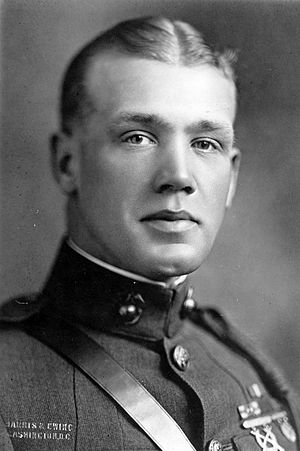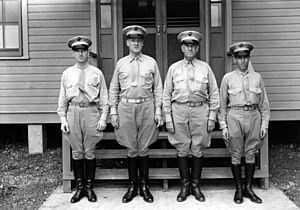Harold C. Roberts facts for kids
Quick facts for kids
Harold Cyrus Roberts
|
|
|---|---|

Roberts as 2nd lieutenant, USMC
|
|
| Nickname(s) | "Bob" |
| Born | October 1, 1898 Buffalo, New York |
| Died | June 18, 1945 (aged 46) Okinawa, Japan |
| Allegiance | United States of America |
| Service/ |
|
| Years of service | 1917–1945 |
| Rank | |
| Service number | 0-3825 |
| Commands held | 22nd Marine Regiment 3rd Defense Battalion |
| Battles/wars | World War I
Nicaraguan Campaign
|
| Awards | Navy Cross (3) Silver Star Legion of Merit Navy and Marine Corps Medal Purple Heart |
Harold Cyrus Roberts (born October 1, 1898 – died June 18, 1945) was a very brave and highly honored officer in the United States Marine Corps. He reached the rank of colonel. He received the Navy Cross three times. This is the second-highest award for bravery in the United States military.
Roberts started his military journey as a Navy medic during World War I. He earned his first Navy Cross during the Battle of Belleau Wood. He bravely helped wounded Marines while under heavy machine gun fire. His second Navy Cross came during the Nicaraguan Campaign in 1928. There, he led Marine patrols against dangerous bandits. He earned his third Navy Cross for leading the 22nd Marine Regiment during the Battle of Okinawa in World War II. Colonel Roberts was killed by a Japanese sniper during the final days of the Okinawa battle.
Contents
Early Life and Military Start
Harold C. Roberts was born on October 1, 1898, in Buffalo, New York. His father, George Fenn Roberts, was a doctor. After finishing high school, Harold joined the United States Navy when the U.S. entered World War I.
He went to basic training at Naval Station Great Lakes in Illinois. Then, he attended Navy medic school at Fort Sam Houston, Texas.
Bravery in World War I
Roberts became a medic attached to the 5th Marine Regiment. He traveled to France to fight in World War I. He showed incredible courage during the Battle of Belleau Wood on June 7, 1918. As a medic, he volunteered to cross an open field. He did this under heavy machine-gun fire to rescue wounded soldiers who were calling for help.
For this brave act, Roberts received his first Navy Cross. This award is given for extreme bravery in combat. He also earned the Silver Star for his actions later in the war.
Joining the Marines
After World War I, Roberts stayed in the Navy. But he wanted to become an officer in the United States Marine Corps. He was made a second lieutenant on June 3, 1922. He then went to officer training at The Basic School in Quantico, Virginia.
Roberts served at Quantico until 1924. Then, he joined the Marine group on the battleship USS Pennsylvania. On this ship, he sailed to Hawaii, Australia, and New Zealand.
Service in Nicaragua and China
In August 1926, Roberts moved to Marine Corps Base San Diego. He was promoted to first lieutenant in November 1927. He was then sent to China for a short time. In January 1928, he went to Nicaragua. There, he joined jungle patrols fighting against bandits led by Sandino.
He showed great skill during this time and earned his second Navy Cross. Roberts also received the Navy and Marine Corps Medal for saving a fellow Marine's life in March 1928. The government of Nicaragua also gave him the Presidential Medal of Merit.
In July 1929, Roberts returned to the U.S. He served at Marine Barracks, Parris Island, South Carolina. Later, he joined the Marine group on the new cruiser USS Houston. He sailed to the Far East, patrolling off the coast of Shanghai, China.
When fighting broke out between China and Japan, Roberts joined the 4th Marine Regiment in June 1931. He served in the Shanghai International Settlement until December 1933. He then returned to the U.S. and served in San Francisco.
Roberts later attended the Base Defense Weapons Course at Quantico. He was promoted to captain in May 1935 and to major in July 1939. In April 1940, he went to Hawaii. He joined the 3rd Defense Battalion as a battery commander. These Marine defense battalions were special Marine units. Their job was to protect naval bases in the Pacific, like Midway Atoll and Wake Island.
In September 1940, Roberts led part of the 3rd Defense Battalion to Midway. He was in charge of the anti-aircraft defense there. In February 1941, he became the second-in-command of the 3rd Defense Battalion. The battalion moved back to Hawaii in October 1941.
World War II
Pearl Harbor Attack
On December 7, 1941, the Japanese attacked Pearl Harbor. Colonel Pepper, the commander of the 3rd Defense Battalion, was away. So, Roberts was in charge. He was woken up by a phone call about the attack. He quickly drove to Pearl Harbor, seeing Japanese planes attacking Navy ships along the way.
Roberts reached the Marine Barracks and immediately started organizing his battalion's anti-aircraft defense. He made sure medics set up aid stations. He also ordered fire safety measures in the barracks, like placing extinguishers and sand buckets. He had cooks prepare coffee and fill containers with water. He organized riflemen to fire at enemy planes. He also had civilians help fill ammunition belts. Roberts directed the defense and fire fighting. He later recommended that his entire battalion be praised for their quick thinking and bravery under fire.
Fighting on Guadalcanal
After Pearl Harbor, Roberts and his battalion helped strengthen the defenses of Midway, Johnston, and Palmyra atolls. He was promoted to temporary lieutenant colonel on May 8, 1942. He then went to Guadalcanal, in the Solomon Islands. He took part in the landing at Tulagi on August 7, 1942.
The 3rd Defense Battalion successfully hit three enemy ships. They also fought off 133 bombing attacks by Japanese planes. Roberts then participated in the Battle for Henderson Field in October 1942. His battalion defended Lunga Point against an enemy attack from the sea. He was promoted to temporary colonel on October 30, 1942.
The 3rd Defense Battalion left Guadalcanal in February 1943. They went to New Zealand. Roberts took command of the 3rd Defense Battalion on March 15, 1943. He received the Legion of Merit with a "V" for valor and the Navy Presidential Unit Citation for his service on Guadalcanal.
Return to the U.S. and Leyte
Roberts returned to the United States in June 1943. He worked at the headquarters of the Fleet Marine Force in San Diego. In October 1944, he went back to the Pacific. He became the Chief of Staff for the Artillery of the V Amphibious Corps. In this role, Roberts took part in the Battle of Leyte in the Philippines.
The Battle of Okinawa
In January 1945, Roberts was sent back to Guadalcanal. It was now a large training base. The new 6th Marine Division was training there for future battles. Roberts joined the division staff. He helped plan and prepare for the Okinawa Campaign.
After two months on Guadalcanal, Roberts sailed to Ulithi in March 1945. The Sixth Marine Division landed on Okinawa on April 1, 1945. They faced very strong Japanese resistance, including artillery, mortars, and snipers. The commanding general was not happy with how the 22nd Marine Regiment was doing.
The general felt that the regiment's commander needed a rest. So, he ordered Roberts to take over. Roberts became the commander of the 22nd Marine Regiment on May 17, 1945. The first thing he did was set up his command post right behind the front lines. He wanted his men to see that their commander was with them. He also wanted a better view of the battle. He led his regiment during fights near Naha and the capture of Sugar Loaf Hill. For his leadership at Sugar Loaf Hill, Roberts earned his third Navy Cross.
On June 18, 1945, the 22nd Marines were fighting on Hill 69. Roberts was at the front, watching the advance of the 2nd Battalion. A Japanese sniper opened fire on him and his executive officer. Roberts was hit in the chest and died a few moments later. His executive officer took command of the regiment.
Colonel Roberts was first buried on Okinawa. Later, he was reburied at Fort Rosecrans National Cemetery in San Diego, California. His wife, Faith Newton Roberts, is buried next to him. They had one daughter, Katherine.
Awards and Decorations
Here are the awards Colonel Roberts received:



